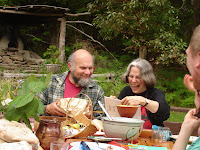





Children's Books
Websites


 It was a joyful revisit of our previous meals and an opportunity to thank Loren and Mary Ruth with some gifts (a cut-paper picture with an uncanny familial resemblance,
It was a joyful revisit of our previous meals and an opportunity to thank Loren and Mary Ruth with some gifts (a cut-paper picture with an uncanny familial resemblance,  and a wood-turned arbutus bowl),
and a wood-turned arbutus bowl),  and Sarah for her TA work (chocolates).
and Sarah for her TA work (chocolates).  We were all blessed to receive a copy of our very own 'Galiano Cookbook', a collection of recipes used on the course.
We were all blessed to receive a copy of our very own 'Galiano Cookbook', a collection of recipes used on the course.  Then, with tummies full of pie and plenty for our minds to mull over, we packed ourselves off to the ferry and our various homes.
Then, with tummies full of pie and plenty for our minds to mull over, we packed ourselves off to the ferry and our various homes. Olives, Hummus, and Pita Bread
Olives, Hummus, and Pita Bread (accompanied by raki/ouzo... much better with water!)
(accompanied by raki/ouzo... much better with water!)
 Afterwards, Ben set up a houka for some to smoke...
Afterwards, Ben set up a houka for some to smoke...

The night ended with a little talent sharing... poetry, banjo, piano, story reading... and an impromptu campfire on the beach.
 The meal looked beautiful, as did the spice illustrations.
The meal looked beautiful, as did the spice illustrations.  We ate with our hands (even though we tried to use only one - as is traditional). We smelt all the beautiful spices as the group cooked and tried to identify them at the table.
We ate with our hands (even though we tried to use only one - as is traditional). We smelt all the beautiful spices as the group cooked and tried to identify them at the table.  We tasted a wide variety of flavours: sweet, sour, salty, bitter, hot... And we heard the crack of poppadums, the crunch of radishes, the gentle whisper of naan scooping up dhal, and the satisfied sounds of diners as they tasted the chai tea icecream!
We tasted a wide variety of flavours: sweet, sour, salty, bitter, hot... And we heard the crack of poppadums, the crunch of radishes, the gentle whisper of naan scooping up dhal, and the satisfied sounds of diners as they tasted the chai tea icecream!
 Appetizer - Poppadums serverd with Mango-Apple Chutney, Lime Pickle, Cucumber Raita, Cilantro (Coriander leaf)-Onion Relish
Appetizer - Poppadums serverd with Mango-Apple Chutney, Lime Pickle, Cucumber Raita, Cilantro (Coriander leaf)-Onion Relish Salad - White and Red Radish Salad
Salad - White and Red Radish Salad
 Entrees (Mains) - Basmati Rice and Naan Bread with Baji Dhal (East Indian Spinach and Lentils) and Roasted Vegetables
Entrees (Mains) - Basmati Rice and Naan Bread with Baji Dhal (East Indian Spinach and Lentils) and Roasted Vegetables Dessert - Chocolate Cake with Chai Tea Ice Cream
Dessert - Chocolate Cake with Chai Tea Ice Cream This day also happened to be Mel's birthday, so the chocolate cake became a birthday cake...

complete with a hidden thimble - a la Nancy Willard's book, "The High Rise Glorious Skittle Skat Roarious Sky Pie Angel Food Cake" (illustrated by Richard Jesse Watson).
"Open your mouth and taste, open your eyes and see -- how good God is." Psalm 34:8



